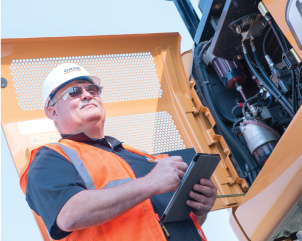Heavy Equipment Washing Best Practices
Consistent heavy equipment cleaning is a key part of machine maintenance and crucial for reducing wear, improving performance, and prolonging lifespan. But washing machinery isn’t always as easy as just cleaning your car. To simplify it and help you complete it the correct way, we've compiled a set of guidelines and recommended practices for preventing the build up of dirt and grime.
Establish a consistent cleaning routine
The optimal frequency for washing your machines will vary based on usage patterns and work environments. In particularly dirty or muddy conditions, cleaning may be necessary every few days or at least once a week. Letting dirt, grease, and debris build up makes removal more difficult and can compromise operational safety and efficiency.
Create a dedicated washing space
Heavy equipment cleaning may be subject to local environmental regulations. Many jurisdictions prohibit the discharge of contaminated water containing fuel residues, grease, and other pollutants into water sources. By setting up a dedicated wash bay or station, you can wash your machinery while adhering to local rules by containing these contaminants.
Your options include constructing a permanent wash bay at your facility or equipment storage site, or investing in a mobile wash pad that can be deployed to various locations. Both permanent and portable solutions function by capturing contaminated water in a basin beneath the wash pad and then channeling it through a water treatment system that removes harmful substances.
Employ a pressure washer
For thorough heavy equipment washing, we suggest using a pressure washer. It's significantly more effective at removing stubborn residues like hardened mud, grease, and debris compared to standard hoses, which often lack sufficient pressure to fully dislodge grime. For particularly tough buildup, consider a hot water pressure washer, as it will break down and dissolve grime, grease, and oil more rapidly and efficiently than cold water, helping conserve time and water.
Wear protective gear
When conducting heavy equipment cleaning and other types of machine maintenance, it's essential to use appropriate protective equipment. Your team should wear full length clothing or coveralls, slip resistant footwear, eye and face protection, and gloves. Proper attire minimizes the risk of exposure to hot water, chemicals, or contaminants during the washing process.
Select appropriate cleaning products
For machinery covered in a combination of organic substances (such as grease and fuel residue) and inorganic materials (like dust and gravel), specific detergents can enhance your heavy equipment washing efforts. Some effective cleaning agents include:
- Acidic pre-soaks and/or aluminum brighteners for oxidation and mineral residue
- High pH detergent to neutralize your low pH presoak & clean normal buildup
- Friction detergent for brush washing that will reduce drying & surface abrasions
- Degreaser for a heavy buildup of grease, fuel spills, and oils
- Concrete and cement cleaner for removing paving materials, lime, fly ash, rust, and water scale
Remove all attachments and accessories
When performing heavy equipment cleaning, it's important to remove any attachments and wash them separately. This approach gives you easier access to accumulated grime and simplifies the overall cleaning process, making it more effective.
For any questions regarding heavy equipment washing or general machine maintenance, please contact our team!

